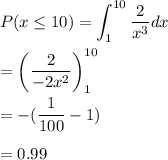
Mathematics, 03.03.2020 18:17 nefertitihorne12
Particles are a major component of air pollution in many areas. It is of interest to study the sizes of contaminating particles. Let X represent the diameter, in micrometers, of a randomly chosen particle. Assume that in a certain area, the probability density function of X is inversely proportional to the volume of the particle ; that is, assume that fX(x) = c x 3 , x > 1, where c is a constant. (a) Find the value of c so that fX is a probability density function. (b) The term PM10 refers to particles 10 µ m or less in diameter. What proportion of contaminating particles are PM10 ? (c) The term PM2.5 refers to particles 2.5 µ m or less in diameter. What proportion of contaminating particles are PM2.5 ? (d) What proportion of the PM10 particles are PM2.5 ?

Answers: 2


Another question on Mathematics



Mathematics, 21.06.2019 20:30
The cost for an uberi is $2.50 plus $2.00 mile. if the total for the uber ride was $32.50, how many miles did the customer travel?
Answers: 3

Mathematics, 21.06.2019 21:30
*let m∠cob = 50°30’, m∠aob = 70° and m∠aoc = 20°30’. could point c be in the interior of ∠aob? why? a. point c could be the interior of aob but it is not the only case b. point c is the interior of aob c. point c is not the interior of aob d. the given is not possible for the plane geometry answer
Answers: 1
You know the right answer?
Particles are a major component of air pollution in many areas. It is of interest to study the sizes...
Questions


Biology, 05.05.2020 08:36

French, 05.05.2020 08:36




Biology, 05.05.2020 08:36


History, 05.05.2020 08:36


Mathematics, 05.05.2020 08:36

Social Studies, 05.05.2020 08:36

Mathematics, 05.05.2020 08:36





English, 05.05.2020 08:36

Biology, 05.05.2020 08:36

History, 05.05.2020 08:36



![\displaystyle\int^{\infty}_{1} \frac{c}{x^3} = 1\\\\\Rightarrow -\frac{c}{2}\bigg[\frac{1}{x^2}\bigg]^{\infty}_{1} = 1\\\\\Rightarrow \frac{c}{2} = 1\\\\\Rightarrow c = 2](/tpl/images/0532/2992/4d7c0.png)






